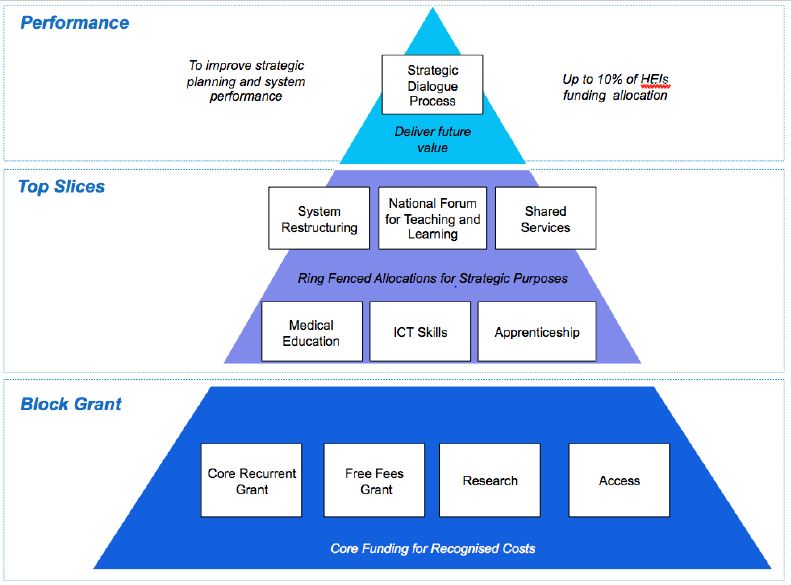The HEA allocates over a billion in state funds annually through what is called the Recurrent Grant Allocation Model – RGAM
The current funding allocation was put in place for the universities from 2006, and on a phased basis for the Institutes of Technology (IoTs) from 2009.
There are 3 separate, but related, elements to the funding allocation model:
- Block grant, including support for research and access.
- Top-slices: i.e. funding ring-fenced for specified purposes, typically for limited periods.
- Performance funding.
The overall approach is summarised in Figure 1.
Figure 1: Overview of the Components of the HEA Recurrent Funding Model

1. The Block Grant
This is funding allocated as a single grant allocation to Higher Education Institutions (HEIs). Internal budgeting for this funding determined by the HEIs themselves, subject to review by HEA. The block grant allocation is comprised of:
- core recurrent grant allocated through a funding formula. The formula is driven by audited prior-year student numbers. These are weighted for the relative costs of providing education in different disciplines. There are additional weightings for research and for access.
- ‘free fees grant’, which has been provided ‘in lieu of tuition fees’ since the abolition of student-paid tuition fees. When tuition fees were abolished in 1995/96, there was a nominal additional fee of £150 Irish pounds for registration and examinations that was paid over to the examining and awarding bodies such as NUI and HETAC. It was this additional fee that, through successive increases, became the €3,000 student contribution of today.
Overall available funding is split into 2 funding ‘pots’: one for universities and colleges (60%) and one for institutes of technology (40%). The ‘free fees grant’ requirement for each of these sub-sectors is top-sliced from each pot and the remaining grant funding for each sector is allocated through the funding model.
Support for Research and Access
Core grant support for research is provided as part of the block grant. This is in recognition of the need to provide a ‘foundation investment’ in research excellence across the system. Institutions have the final say on the distribution of their budgets between teaching and research, in accordance with their mission and objectives.
The major portion of core grant support for research is provided through the research student numbers that are included in each institution’s overall student numbers and in the allocation formula.
In addition to the grant funding that is based on research student numbers, there is, in the universities’ ‘pot’ only, a research top-slice of 10% and there is an allocation of €5M Research and Innovation Grant provided to the Technological Sector.
This is allocated to each institution based on research metrics to recognise research success which includes:
- Competitively earned research income per academic staff member;
- Output of research degrees over the last 3 years;
- Knowledge Transfer Metrics.
Core funding for access performance involves an additional weighting of 33% of the weighting for a non-laboratory student being added to the normal student weighting to take account of the additional costs of recruiting and retaining students from under-represented backgrounds. Thus, a science student from a target socioeconomic group, or with a disability, attracts a weighting of 1.7 for discipline plus 0.33 for access.
2. Top Slices
Top-sliced, ring-fenced allocations for specific strategic or important purposes are earmarked from time to time by either the Department of Education or Skills or by the HEA.
At present, top-sliced funding is provided to support some institutional restructuring arising from the national strategy (Technological Universities [TUs], mergers, etc.). Also, it is used to grow new or expanded programmes, discipline restructuring arising from reviews of provision (Medical Education, Nursing Education), strategic innovation funding (National Forum for Enhancement of Teaching and Learning), and new or expanded programmes to meet identified skills’ gaps.
Other existing top-slices include funding for pension obligations, funding for shared service initiatives (e.g. HEAnet, IReL [e journals], Irish Survey of Student Engagement), and protected funding to reflect additional cost components related to important but vulnerable areas (e.g. practice-based music schools).
A general principle of funding that is top-sliced and earmarked for new developments is that funding should progress through stages of being ring-fenced, then reviewed, and finally being either mainstreamed or discontinued. Typically, there is an up-front agreement on the duration of ring-fencing.
3. Performance-Based Funding
Since 2013, a performance funding component has been established, which allows for the withholding of up to 10% of the allocated block grant (including free fees) based on verified performance against agreed targets for the preceding year.
This approach centres around a system of agreed 3-year mission-based compacts. In these compacts, Higher Education Institutions (HEIs) propose their own targets relevant to their agreed mission and profile in line with objectives set by the Minister for Education and Skills as part of an overall system performance framework. Proposed targets are subject to challenge by an external expert panel, and are formally agreed in a dialogue process. The HEA co-ordinates the approach at a system level in order to ensure pursuit and ultimate achievement of the Minister’s system-level goals.
In January each year we allocate our grant for the coming year and confirm our out turn (actual spend) for the previous year. We have the following financial data
- an outturn figure, this is what we paid each institution in the previous year, under various headings;
- a core grant allocation figure, which is specifically what we know each institution will receive in core funding areas, for the next year. (each institution will receive funding under top slice initiatives, and competitive calls which are measured as the year progresses, this is not included here, but is included in the outturn the following January).